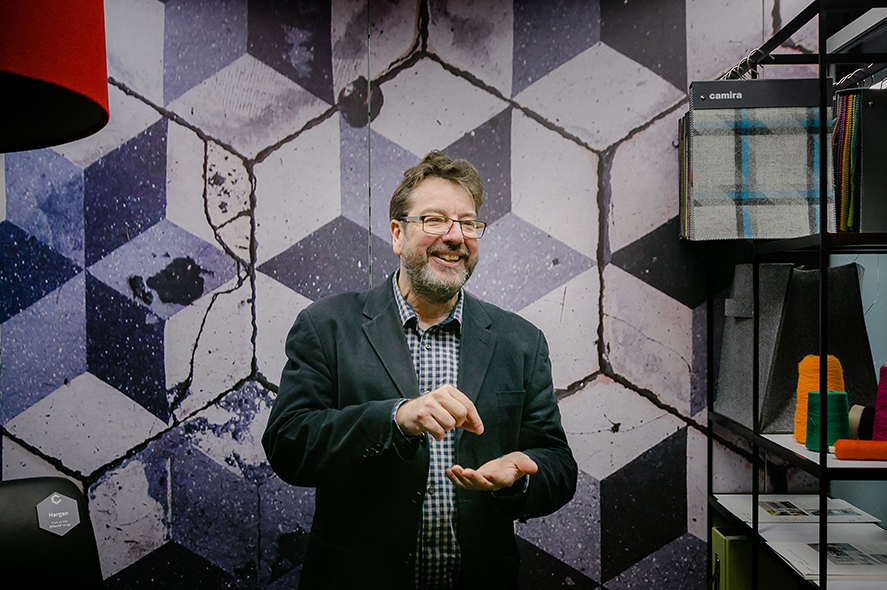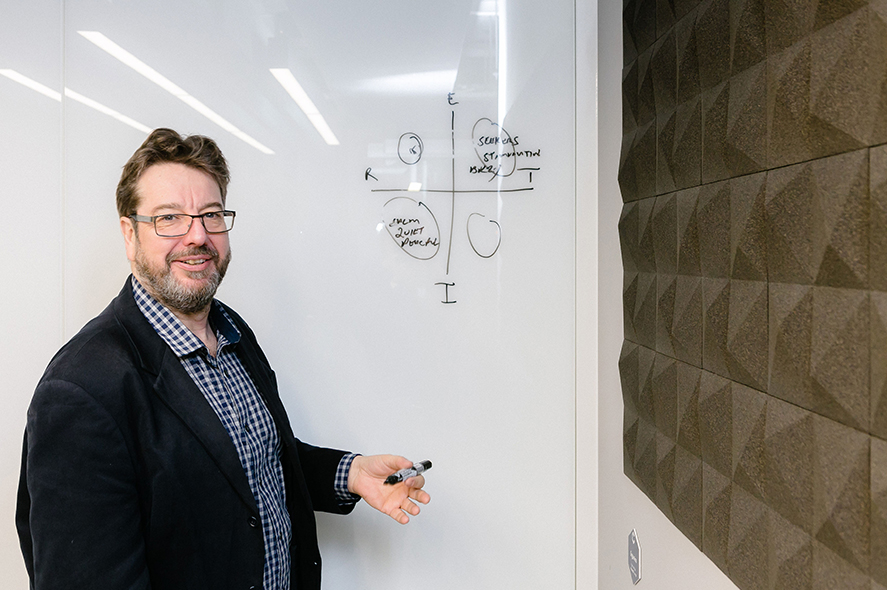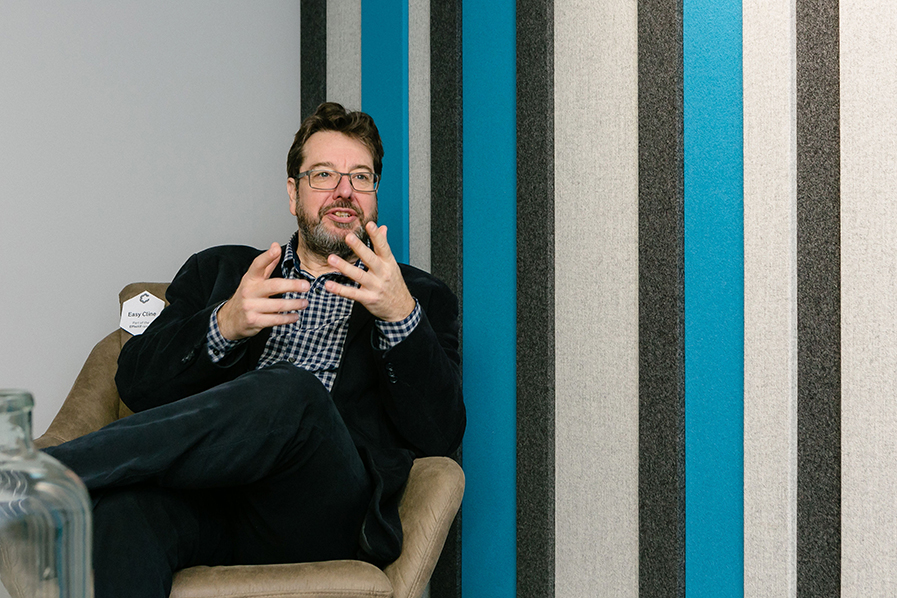|
Never before has the ‘psychology of designing workspaces for people’ been quite at the forefront of interior office design. Championing this school of thought is environmental psychologist Nigel Oseland, who founded both Workplace Unlimited and the annual Workplace Trends conference. Nigel works with his clients to redefine their work styles and create cost-effective and space-efficient workplaces that enhance concentration, collaboration, creativity and business performance. And he recently sat down to talk about evidence-based research regarding innovative working environments and, most importantly, how to design and deliver unique spaces that cater for all personality types. Creatif: Why did you decide to create a business that focuses on improving workspaces? NO: I was a psychologist and a researcher, and somewhere along the way, I got to work on space planning and efficiencies. People were being crammed into horrible spaces because it was efficient, but I came in to this to create spaces for people to work effectively in. When I work with clients, I agree that we have to design for efficiency and cost but we shouldn’t do this at the detriment of people’s well-being and performance. It’s a simple balance [and] I still think that a lot of the facilities and workplace industry still focus on that ideology of ‘let’s create minimal space’ and forget that what they’re doing is having a knock-on effect on business.
Creatif: Please can you tell us more about innovative working environments (IWE) and what they mean to you? NO: “Through my research, I explore how we can provide creative spaces to encourage creativity and innovation. I’m probably more known for psycho-acoustics and the zoning of offices, but I’ve also been looking at how different personality types require various spaces for meeting and interaction, and how this influences how we design innovative working environments. All of my work is around making sure we cater for the range of different people who use a space. In particular, I’ve been looking at personality types. Recently, I heard someone say ‘oh we need to cater for introverts now?’ and I thought ‘well yes, of course we do!’ All of this feeds into office design and how we need to be providing spaces that accommodate people with different cognitive functions. You have to understand the personalities in order to design the right spaces for them. Creatif: Can you give us an example of a company that pays real attention to different cognitive functions? NO: A couple of organisations I recently visited actively employ people on the autistic spectrum because of their high cognitive functioning. What is fascinating, but not surprising, is that they need to have very subdued, calming spaces. I see this as an extension to my research on personality types and office zoning. Creatif: You often discuss well-being. Do you think that plays an important part of designing workspaces for people?
NO: “I do think we can use design to help wellness and well-being. However, there is a bit of me that wonders if it’s a bandwagon. I’m not saying that we shouldn’t be designing spaces for wellness and well-being, but people are taking a diluted version by giving them a pot plant and telling them to be happy with it. Creatif: How do you combine innovative working environments that support well-being? NO: “My main concern is how we design for psychological needs and activity. Effective design should be layered [and include] aspects that enhance well-being. I think of activity-based working as a layer of design which requires its own zoning. Then, I believe you need a psychological layer that caters for different personalities - it’s another layer of design that you put on top of the activity-based working.” |
Creatif: In terms of the innovative working space, what would you say are the key features? NO: Research shows that getting up from your desk - having a walk, going into nature, being involved in a solo activity, taking a different route to work, all of these things - unlock the neural pathway and invite the eureka moment that’s the real mark of originality, which is what creativity is all about. In Sky Central, for example, there are lots of different work settings, so people have an active choice: where do I work best? Where do I want to work today? What I like about Sky is it’s got lots of different walkways, bridges and stairways and I think that helps people explore the building. This opens up neural pathways by doing something different, sitting somewhere different and taking a different route through your workplace. Walking around the building prevents people from being stagnated. That’s an element that I think will encourage creativity and innovation. You do need collaborative spaces as people come together to brainstorm, but actually, it’s important that workers go away and develop the idea in solitary. There are the stereotype clichés of ‘oh we’re designing for creativity, so it’s got to be fun, stimulating and buzzing’ but actually what people need is space to go away and think. With any innovative working space, I like to see some evidence rather than basing a design on what we think we know. That’s why it’s great that I can do the research and then hand over the facts to architects so that they can then do their wonderful designs, but don’t design blindly. Creatif: Can you provide any examples of what your would class as an 'innovative working environment'? NO: “I think it’s difficult to find a single office, but I think you can find examples of ideas in different offices. The Crown Estate has just got a platinum WELL certificate – I think it may be the first platinum in Europe – and they’ve really focused on the biophilic design which, in my opinion, will really help creativity by just giving people spaces with an attachment to nature.
They’ve used moss walls for sound absorption, so it’s functional as it’s reducing noise – you can hear the sound drop straight away – but it looks great and it’s got that biophilic element to it. It’s also got lots of smaller areas where people can hide away, focus and concentrate, and a library space for people to work without being interrupted. This is something I promote with my clients; we can create whole distraction-free zones.” Creatif: What do you think about the elements of ‘work and play’ that are being introduced at companies like Lego? NO: I think it’s about allowing people the time and freedom to explore and use different mediums. I’ve done different workshops where people have been given paper, magazines, Lego, Plasticine and been asked to design the ideal workspace using these mediums. If that’s how some people will perform better, then don’t stop them doing it but for an introvert that would be a terrifying experience. It comes back to the choice of flexibility and freedom. I’m about to do a workshop with highly introverted scientists, so how do I get information from them without making them feel uncomfortable? If I went into a workshop with Plasticine, they’d hate it. Creatif: Creatif provides acoustic solutions and movable walls, knowing that how you open and close a space has an effect on the working landscape. Are you an ambassador for multi-functional furniture and workplace designs? NO: One reason we don’t like walls and partitions is that it ‘fixes’ the design. A building is going to be up for 100 years, and a fit out, whilst people say they change it every 5 years, a lot of them are around for 15-20 years. But the organisation changes annually. The more furniture solutions you can bring in - sofas with hoods and screens around them, movable partitions and smaller pods – is great because as the organisation evolves and different people move into the space, you can adapt it much easier than if you’ve got partitions that have to be ripped out. I always say to clients that it’s worth paying a little bit more for adaptability and flexibility because long term it will save you time, money, and reduce disruption. |



